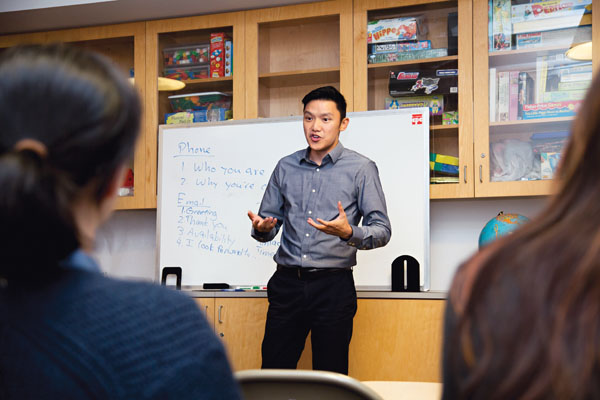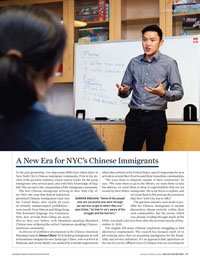Alumni Gazette
 BARRIER BREAKER: “Some of the people who are successful now went through our services to get to where they are,” says Chiew. “So they’re very aware of the struggle and the barriers.” (Photo: Shannon Taggart for Rochester Review)
BARRIER BREAKER: “Some of the people who are successful now went through our services to get to where they are,” says Chiew. “So they’re very aware of the struggle and the barriers.” (Photo: Shannon Taggart for Rochester Review)In the past generation, two important shifts have taken place in New York City’s Chinese immigrant community. First is the decline of the garment industry, a main source of jobs for the many immigrants who arrived poor, and with little knowledge of English. The second is the composition of the immigrant community.
The first Chinese immigrants arriving in New York City after 1965—the year that federal legislation permitted Chinese immigration back into the United States after nearly 80 years of virtually uninterrupted prohibition—were mostly from Taiwan and Hong Kong. The dominant language was Cantonese. Now, new arrivals from China are more diverse than ever before, with Mandarin-speaking Mainland Chinese now eclipsing the earlier Cantonese-speaking Chinese- American community.
As director of workforce development at the Chinese-American Planning Council, Simon Chiew ’02 is helping immigrants as well as businesses navigate the new landscape. Chiew, who was born in Malaysia, and whose family was assisted by a similar organization when they arrived in the United States, says it’s important for new arrivals to extend their lives beyond their immediate communities.
“We want them to integrate outside of their community,” he says. “We want them to go to the library, we want them to take the subway, we want them to shop in supermarkets that are not owned by their fellow immigrants. We want them to explore, and we want them to live and use the resources that New York City has to offer.”
The garment industry once made it possible for Chinese immigrants to sustain themselves almost entirely within their own communities. But the sector, which was already eroding through much of the 1990s, was dealt a decisive blow after the terrorist attacks of September 11, 2001.
The tragedy left many Chinese employees struggling to find alternative employment. The council has focused much of its job training since then on preparing immigrants for the hospitality and service industries. It’s an approach that capitalizes on the rise of a newly affluent class of Chinese who are traveling the world and spending large sums of money. By 2020 overseas spending by Mandarin-speaking Chinese is projected to top $458 billion per year.
The program Chiew runs, the LVMH Moët Hennessy Louis Vuitton Fundamentals in Luxury Retail program, is a collaboration of the council, the luxury retailer, and the Parsons School of Design. The program, to which Mandarin-speaking immigrants must apply, takes the successful applicants through eight weeks of classroom instruction on subjects from fashion history to retail operations, and a two-week internship at one of the stores. Of the 60 people who have participated in the program since it began in 2014, 80 percent have found employment in stores such as Louis Vuitton, Prada, and Dior.
“Most of our students never saw themselves in luxury retail,” says Chiew. “A lot of the people we are working with are severely underemployed or long-term unemployed.”
Salina Zhao, an alumnus of the program, came to the United States from southern China at the age of 11. Before she began her training, she was afraid to set foot inside a luxury retailer. “I was intimidated,” she recalls. “If I can’t afford something like that I wouldn’t even enter into the store.”
As part of the program, Zhao interned at Christian Dior at the Saks Fifth Avenue flagship store. She was hired by Dior right after. She says Chiew prepared her well.
“I think Simon prepares us as much as possible for everything that we’re going to experience in the future. He will spend an hour or two going through our résumé, making sure it’s as professional as possible, and going through even small details like how we dress up and how to professionally answer the questions.”
Now she looks forward to career advancement within the company. “I think this program really gave us a huge opportunity to get into a different environment,” she says, describing the training experience as a valuable shortcut into a world that would otherwise be hard to reach.
Chiew says successful alumni are part of what will help the council’s training programs to continue.
“Some of the people who are successful now went through our services to get to where they are. So they’re very aware of the struggle and the barriers,” he says. “Our focus on building our alumni network and having them contribute either with funding or with their time has really improved. People do want to give back.”
—Maya Dukmasova ’12

